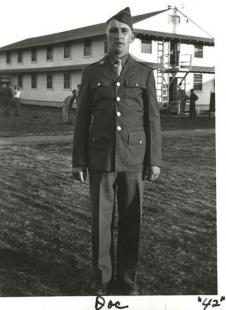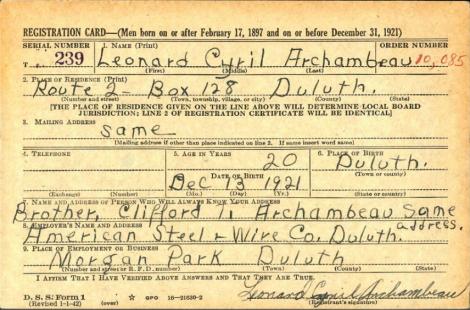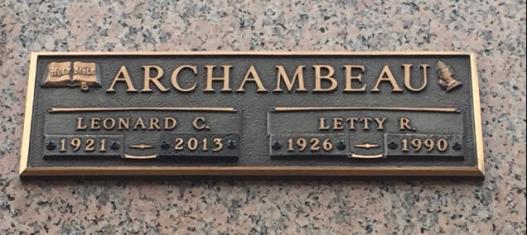Leonard Cyril Archambeau
Era: World War II
Military Branch: Army

ARCHAMBEAU, Leonard Cyril
Leonard Cyril Archambeau was born on December 13th 1921 to Cyril & Alvina Archambeau in Duluth, Minnesota.
Mr. Archambeau was inducted into the U.S. Army in August 1942 at Ft. Snelling, Minnesota during WWII.
He served as a tank driver with the 601st Tank Destroyer Battalion in Tunisia and Algeria, North Africa. He rose to the rank of Technician Fourth Class (TEC4).
In his words: "We had 37 mm. on a 3/4-ton Dodge in Africa. It was no match for the German 88. Later, we got half-tracks with the old French 75 mm. which we called 'Purple Heart boxes.' At El Guettar in Tunisia we met the Germans and lost heavily. We went back to regroup and got the new M-10 tank with the 3-inch naval gun, a fine piece of equipment. The next move was to Sicily and then to Salerno, and again we had many casualties."
Made their third D-Day landing at Anzio, Italy. "February 4 to the 24th of May was all we could do to hold the line. Then, we made the break to Rome. Above Rome we were pulled back to regroup and made another landing at St. Tropez, France. From there it was on to the Siegfried Line with a lot of fighting and casualties. The next was crossing the Rhine river on pontoon bridges. We ended up in Salzburg, Austria, when the war ended."
TEC Archambeau was honorably discharged on October 20th 1945. After the war he returned home and married Letty Ruth [Pilcher] and they started a family.
Mr. Archambeau died on December 10th 2013 at 91 years of age in Esko, Minnesota. He is buried at Sunrise Memorial Park Cememtery in Hermantown, Minnesota
Source(s): Hometown Heroes: The Saint Louis County World War II Project, page 25.
Mr. Archabeau served in World War II in the European Theater in the U.S. Army from August 26, 1942, until October 20, 1945. He was assigned to 601st Tank Destroyer Battalion and achieved the rank of Technician Fourth Grade.
Mr. Archambeau was born in Duluth, Minnesota, the son of Cyril and Alvina Archambeau.
He was decorated with two Presidential Unit Citations, one French Decoration, European Theater Medal.
Source(s): Veterans’ Memorial Hall Veteran History Form; veteran recollections (see below); original entry on VHM website (see below)
“Left Proctor by Greyhound bus for Fort Snelling. I was at Fort Snelling about a week getting shots and a taste of Army life.
“Was then shipped out to Fort Knox for my basic training of 13 weeks. From there I was transferred to Camp Campbell for about three weeks and then to Camp Kilmore, New Jersey, for about a week, and then to New York for overseas travel by ship to Oran, Africa, to a tent city, then on to my unit, which was 601 Tank Destroyer Battalion.
“I was a loader on a ¾ Dodge truck with a 37mm [gun], and we had march[ing] orders every night. And when we stopped for the night, the first thing you did was [dig] a fox hole. I don’t know to this day if we were going forward or backward.
“[At a] later date, we got half-tracks with the 75mm [guns], which proved to be not much better. We got into a tank battle at El Guettar and lost our whole company. We went back and regrouped and we got the M10 tank destroyer with the 3” naval gun.
“We then were scheduled for the invasion of southern Italy. Again our losses were quite heavy. We were in southern Italy for about 4 months until we reached Rome. We were pulled back to Naples and regrouped for another landing on Anzio.
“We made a beachhead, but it was a long, hard fight. Every night the Germans would bomb us, and the general told us, ‘The ship that brought you here has left, so it’s up to us to fight or swim.’
“This was another long, hard battle. About three months later, we joined with our troops from the south.
“Again we were pulled back to Naples to regroup and waterproof our tanks for another landing at St. Tropez, France, with the 3rd Infantry Division. We rolled through southern France with not too much trouble until we got to the border of Germany.
“Another great battle until we reached Nuremberg [check]. When we got the town secured we held up for a couple of weeks before the next big encounter, which was crossing the Rhine River, taking a 30-ton tank on a pontoon bridge. It was like going down a mountain: the pontoon sank at least 3 or 4 feet.
“The next place was the Siegfried Line of concrete formation and pillboxes with the German 88, and they sure knew how to use them.
“Our next big city was in Salzburg, Austria.
“On May 8, the war ended. This is no way the whole story, but it will give you some idea of the travel in three years and two months.”
Source(s):
Albert J. Amatuzio Research Center | Veterans Memorial Hall (vets-hall.org)
Page 1 WWII Draft Registration Cards - Fold3
Leonard Cyril Archambeau (1921-2013) - Find a Grave Memorial



